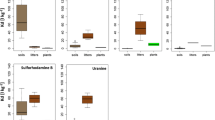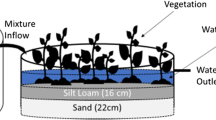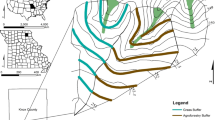Abstract
Vegetated buffers of different designs are often used as edge-of-field treatment practices to remove pesticides that may be entrained in agricultural runoff. However, buffer system efficacy in pesticide runoff mitigation varies widely due to a multitude of factors including, but not limited to, pesticide chemistry, vegetation composition, and hydrology. Two experimental systems, a control (no vegetation) and a grass–wetland buffer system, were evaluated for their ability to retain diazinon and permethrin associated with a simulated storm runoff. The two systems were equally inefficient at retaining diazinon (mean 9.6 % retention for control and buffer). Grass–wetland buffers retained 83 % and 85 % of cis- and trans-permethrin masses, respectively, while the control only retained 39 % and 44 % of cis- and trans-permethrin masses, respectively. Half-distances (the distance required to decrease pesticide concentration by one-half) for both permethrin isomers were 26 %–30 % shorter in grass buffers (22–23 m) than in the control (32 m). The current study demonstrates treatment efficacy was a function of pesticide properties with the more strongly sorbing permethrin retained to a greater degree. The study also demonstrates challenges in remediating multiple pesticides with a single management practice. By using suites of management practices, especially those employing vegetation, better mitigation of pesticide impacts may be accomplished.
Similar content being viewed by others
References
Anderson B, Phillips B, Hunt J, Largay B, Shihadeh R, Tjeerdema R (2011) Pesticide and toxicity reduction using an integrated vegetated treatment system. Environ Toxicol Chem 30(5):1036–1043
Arora K, Mickelson SK, Helmers MJ, Baker JL (2010) Review of pesticide retention processes occurring in buffer strips receiving agricultural runoff. J Am Water Resour Assoc 46(3):618–647
Bennett ER, Moore MT, Cooper CM, Smith S Jr (2000) Method for the simultaneous extraction and analysis of two current use pesticides, atrazine and lambda-cyhalothrin, in sediment and aquatic plants. Bull Environ Contam Toxicol 64:825–833
Bereswill R, Streloke M, Schulz R (2013) Current-use pesticides in stream water and suspended particles following runoff: exposure, effects, and mitigation requirements. Environ Toxicol Chem 32(6):1254–1263
Brady JA, Wallender WW, Werner I, Fard BM, Zalom FG, Oliver MN, Wilson BW, Mata MM, Henderson JD, Deanovic LA, Upadhaya S (2006) Pesticide runoff from orchard floors in Davis, California, USA: a comparative analysis of diazinon and esfenvalerate. Agric Ecosys Environ 115:56–68
California Department of Pesticide Regulation (CDPR) (2013) Summary of pesticide use report data 2011: indexed by chemical. www.cdpr.ca.gov/docs/pur/pur11rep/chmrpt11.pdf
Crosby DG (1998) Environmental transport. Environmental toxicology and chemistry. Oxford University Press, New York, pp 51–67
Dabney SM, Moore MT, Locke MA (2006) Integrated management of in-field, edge-of-field, and after-field buffers. J Am Water Resour Assoc 42(1):15–24
de Vlaming V, DiGiorgio C, Fong S, Deanovic LA, de la Carpio-Obeso Paz M, Miller JL, Miller MJ, Richard NJ (2004) Irrigation runoff insecticide pollution of rivers in the Imperial Valley, California (USA). Environ Poll 132:213–229
Evans JR, Edwards DR, Workman SR, Williams RM (1998) Response of runoff diazinon concentration to formulation and post-application irrigation. Trans ASAE 41(5):1323–1329
Imgrund H (2003) Environmental fate of permethrin. www.cdpr.ca.gov/docs/emon/pubs/fatememo/permethrin.pdf
Krutz LJ, Senseman SA, Dozier MC, Hoffman DW, Tierney DP (2004) Infiltration and adsorption of dissolved metolachlor, metolachlor oxanilic acid, and metolachlor ethanesulfonic acid by buffalograss (Buchloe dactyloides) filter strips. Weed Sci 52:166–171
Lacas JG, Voltz M, Gouy V, Carluer N, Gril JJ (2005) Using grassed strips to limit pesticide transfer to surface water: a review. Agron Sustain Dev 25:253–266
Liu W, Gan JJ, Lee S, Kabashima JN (2004) Phase distribution of synthetic pyrethroids in runoff and stream water. Environ Toxicol Chem 23:7–11
Lizotte RE Jr, Moore MT, Locke MA, Kröger R (2011) Effects of vegetation in mitigating the toxicity of pesticide mixtures in sediments of a wetland mesocosm. Water Air Soil Pollut 220:69–79
Lutnicka H, Bogacka T, Wolska L (1999) Degradation of pyrethroids in an aquatic ecosystem model. Water Res 33(16):3441–3446
Moore MT, Denton DL, Cooper CM, Wrysinski J, Miller JL, Reece K, Crane D, Robins P (2008) Mitigation assessment of vegetated drainage ditches for collecting irrigation runoff in California. J Environ Qual 37:486–493
Moore MT, Kröger R, Cooper CM, Smith S Jr (2009) Ability of four emergent macrophytes to remediate permethirn in mesocosm experiments. Arch Environ Contam Toxicol 57:282–288
Munn MD, Gilliom RJ, Moran PW, Nowell LH (2006) Pesticide toxicity index for freshwater aquatic organisms, 2nd ed. US Geological Survey Scientific Investigations Report 2006-5148, 81 pp
Otto S, Cardinali A, Marotta E, Paradisi C, Zanin G (2012) Effect of vegetative filter strips on herbicide runoff under various types of rainfall. Chemosphere 88:113–119
Poletika NN, Coody PN, Fox GA, Sabbagh GJ, Dolder SC, White J (2009) Chlorpyrifos and atrazine removal from runoff by vegetated filter strips: experiments and predictive modeling. J Environ Qual 38:1042–1052
Schmitt TJ, Dosskey MG, Hoagland KD (1999) Filter strip performance and processes for different vegetation, widths, and contaminants. J Environ Qual 28:1479–1489
Sharom MS, Solomon KR (1981) Adsorption–desorption, degradation, and distribution of permethirn in aqueous systems. J Ag Food Chem 29:1122–1125
Solomon KR, Yoo JY, Lean D, Kaushik NK, Day KE (1985) Dissipation of permethrin in limnocorrals. Can J Fish Aqua Sci 42(1):70–76
Spencer WF, Cliath MM (1991) Pesticide losses in surface runoff from irrigated fields. In: Pawlowski L et al (eds) Chemistry for the protection of the environment. Plenum Press, New York, pp 277–289
Stehle S, Elsaesser D, Gregoire C, Imfeld G, Niehaus E, Passeport E, Payraudeau S, Schäfer RB, Tournebize J, Schulz R (2011) Pesticide risk mitigation by vegetated treatment system: a meta-analysis. J Environ Qual 40:1068–1080
US EPA (2006) Permethrin facts [Reregistration Eligibility Decision (RED) fact sheet]. EPA 738-F-06-012, Washington
Zhang X, Liu X, Zhang M, Dahlgren RA, Eitzel M (2010) A review of vegetated buffers and a meta-analysis of their mitigation efficacy in reducing nonpoint source pollution. J Environ Qual 39:76–84
Acknowledgments
Thanks to Renee Russell for pesticide analyses. Sampling field assistance was provided by team members of the Water Quality and Ecology Research Unit. Mention of trade names or commercial products in this article is solely for the purpose of providing specific information and does not imply recommendation or endorsement by the US Department of Agriculture (USDA). The USDA is an equal opportunity employer and provider.
Author information
Authors and Affiliations
Corresponding author
Rights and permissions
About this article
Cite this article
Moore, M.T., Kröger, R., Locke, M.A. et al. Diazinon and Permethrin Mitigation Across a Grass–Wetland Buffer. Bull Environ Contam Toxicol 93, 574–579 (2014). https://doi.org/10.1007/s00128-014-1357-8
Received:
Accepted:
Published:
Issue Date:
DOI: https://doi.org/10.1007/s00128-014-1357-8




